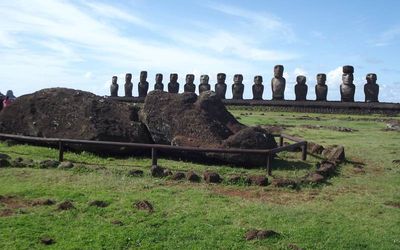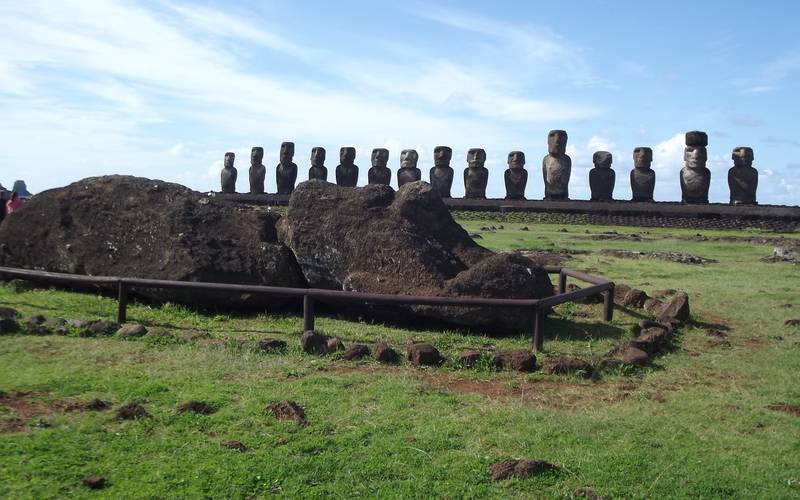The Moaïs are the name given to the statues of Easter Island. There are 887 mostly half of them along the coast of the island, the other half still being carved in the main quarry of the island . It is a very curious distribution since it means that a lot of statues were started at the same time, and that all were abandoned at the same time, brutally.

Moais lying
The Moaïs, as they are called locally, measure between 2 and 10m for a weight of up to several tens of tons. They represent men, they are carved according to a unique archetypal based on simplified anatomical elements. They have a long nose, a strong neck, a clear forehead and long ears. They sometimes have a pukao , a hat made of red tuff.
The Moaïs are a representation of the ancients, they are integrated in the cult of the ancestors, a cult widespread in the Polynesian islands and which was imported at the same time as the settlement of the island, towards 1200. One estimates several years the time that was necessary between the cutting, the transport, the installation on site and the decoration. They were almost all carved in the quarry Rano Raraku , the southeast of the island, then routed s on Ahus, ceremonial platforms that are found throughout the island, or simply on an isolated site. Some were abandoned during transport, they lie on the back, on the ground. Those who were permanently settled had eyes made of white coral and red tuff or black diorite, to simulate the eyes.
The community that built the Moais was the " Haumaka ", a people of Austronesian origin who came from neighboring islands around 1200 AD. They are the ones who built the Moais. Around 1500, maybe a little later, they changed their worship and then worshiped Make-make , the bird god. The Moais were abandoned at that moment . This abandonment was so sudden that the statues under construction, and there were many, were left as they were, vaguely buried for some of them. The first European incursions on the island, from the 16th century, will mark the end of this civilization. If Premi eras years take place as normal , with relations between the discovery Hau-maka and E uropéens the mid-nineteenth century saw the arrival of Peruvian slavers who rounded up almost all of the population. Almost disappeared, the original community was saved by the massive introduction of a new Polynesian population, "Rapa" which, mixing with E uropéens and some C hinois, still form nowadays the population of the island.
Locations, dimensions, description
The statues of Easter Island are curiously all oriented towards the interior of the island, and they are almost all near the coast. This implantation is rather original, because often, in such cases, the statues of an island are directed towards the sea, so that they impose themselves to the navigators. It is probably the isolation of the island, and therefore the few ships that could come there, which rendered this orientation useless , but it is rather a religious reason which pushed the inhabitants to implants them voluntarily towards the interior since it is believed today that these statues represented the ancestors of the clans who lived there, and it is therefore logical that they look at the land rather than the ocean.
If we consider them individually we can say that the statues of Easter Island are between 5 and 12m, with exceptions. The first statues were approximately human-sized, that is to say between about 2m. The largest measuring 21m, but it is exceptional not only by its size, but also by the fact that it has never been completed: It is still, today, in the stone quarry.
Learn more about the description of the statues of Easter Island, or their locations and size.
Easter Island
Easter Island has the distinction of being the most distant island of all land, that is to say that the nearest land is about 2000km away. It is a volcanic island, it has 3 ancient volcanoes that form the 3 mountains of its relief. She has no water, she is too small for that. In order for life to be possible on the spot it was necessary that fresh water be available there, and it was the case thanks to the three craters of the volcanoes which serve, still today, of lake.
Learn more about Easter island.





















